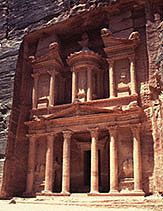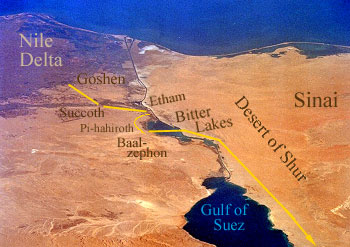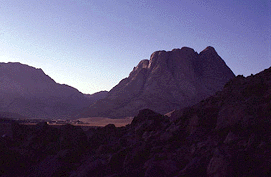Reviews
The Search for the Real Mt. Sinai
A video directed by Steve Greisen. Produced by Reel Productions, 1998.
Reviewed by Jeffrey J. Harrison
Adventure movies like this are lots of fun. And the claim that Mt. Sinai is in Saudi Arabia is very popular right now. Witness all the recent books that advance the same idea: In Search of the Mountain of God: The Discovery of the Real Mt. Sinai by R. Cornuke and D. Halbrook, The Gold of Exodus: The Discovery of the True Mount Sinai by H. Blum, and The Mountain of Moses: The Discovery of Mount Sinai by L. Williams. So I was willing to give this new location at least as much credit as the fifteen other identifications of Mt. Sinai that have been made over the years. But in spite of the high quality of the video itself, there is little here to support its claims, nor the similar claims made by these popular books.
One of the most blatant factual errors made in the video is claiming that a Roman-era house, built more than a thousand years after the time of the Exodus, is an altar from the time of Moses—an “altar” far larger than the dimensions for an altar given by Moses in the Bible (Exo. 27:1). The pieces of the columns that once adorned this house (identified in the video as the “pillars” set up by Moses) are so clearly shown that I recognized them right away as Roman, even before I checked what the archeologists had to say about the site. The saddest part is that the two so-called “experts” they pulled in didn’t catch the obvious error. But that’s just the tip of the iceberg. Let’s go back and examine the argument of this film (and of these books) point by point.

Historical Error
The argument for locating Mt. Sinai in Saudi Arabia is most compelling when looked at with modern maps of the region. But the boundaries have changed over time. “Arabia” at the time Paul was writing (Gal. 4:25; Mt. Sinai in Arabia
) was the kingdom of the Nabateans, ruled from Petra, the famous “rose-red” city, a top tourist attraction in the modern nation of Jordan. This ancient kingdom, unlike modern Arabia, included the Sinai peninsula. So to claim that the real Mt. Sinai cannot be in Sinai because of Gal. 4:25 is incorrect.
In the same way, for the children of Israel to “leave Egypt” would imply going east of Sinai on a modern map. But Egypt proper did not include Sinai in the Biblical period. Sinai, along with other surrounding desert regions, was considered strange and foreign to the Egyptians, a place where people quite different than themselves were known to dwell: the Shasu desert dwellers whom the Egyptians did not like or trust. The Egyptians didn’t have permanent bases with troops stationed in Sinai (as claimed in the video), except along the important military road that ran along the northern coast of Sinai. Rather, their mining expeditions in southern Sinai were just that: a temporary presence that lasted as long as the mining expedition did, after which all involved returned to Egypt. To claim that to “leave Egypt” the children of Israel had to go beyond Sinai does not agree with the historical evidence.
It’s true that Bible maps once located the tribal territory of Midian (identified with Mt. Sinai in Exo. 3:1) in modern Saudi Arabia. But recent archeological evidence has firmly established the presence of Midianites in the Sinai peninsula, as at Timnah in southern Israel. So here again, the evidence does not disprove a Mt. Sinai in Sinai.

But the biggest problem faced by our explorer “guides” (Williams and Cornuke) is the miraculous crossing of the sea, which they place east of Sinai. The Bible says that the children of Israel came out of the sea and into the desert of Shur (Exo. 15:22). This desert is well known from historical records: it was a “wall” of desert (Shur means “wall” in Hebrew) lying along the eastern edge of Egypt proper, that is, along the western side of the Sinai peninsula, just east of the modern Suez Canal (see the photo). This makes it impossible that the crossing took place from the Sinai peninsula into Saudi Arabia.
It’s true that the traditional Mt. Sinai (Jebel Musa) lacks archeological evidence of the Exodus. But that doesn’t argue in favor of a site in Saudi Arabia. At least ten different mountains have been proposed as the true Mt. Sinai in the Sinai peninsula, all of which match the Biblical data better than a location in Saudi Arabia. But then, what archeological evidence can we expect from the short stay of the Israelites at the mountain, a visit of only nine months according to the Bible? Surely this was not long enough to build any permanent stone structures that would have been preserved through the centuries. Can you identify the spot where a group of Bedouin camped two years ago? Just like the Israelites, they take their tents with them when they leave. Evidence of long scale, permanent occupation, with stone dwellings like those shown in the video, actually argues against this site being Mt. Sinai, since the Bible makes no mention of a permanent settlement there.

In their attempt to discredit the traditional Mt. Sinai, our explorer guides introduce the bizarre story that the traditional site was identified by a fortune teller in the 3rd cent. AD! In fact, the first historical identification of the traditional Mt. Sinai (Jebel Musa) comes to us from Christian monks who lived as hermits in the area. Unfortunately, we don’t know why they identified this mountain with Mt. Sinai. Perhaps they had access to information that is no longer available today. But again, doubt cast on the traditional Mt. Sinai does not support a Mt. Sinai in Saudi Arabia.
Biblical Error
One of our guides in the video mentions that the location of the miraculous sea crossing is identified in Scripture as Yam Suf, which he translates “sea of land’s end,” and locates at the southern tip of Sinai. But in fact, Yam Suf is not the location of the sea crossing, but rather the name of the sea itself (Exo. 15:4). Yam Suf actually means (look in any Bible reference) “the Sea of Reeds.” This tells us that the body of water crossed by the Israelites had suf plants (reeds) growing in it. This does not match any branch of the Red Sea, which is a salt water sea and therefore does not have reeds growing in it.* The name Yam Suf (Sea of Reeds) points instead to the Bitter Lakes or one of the other bodies of fresh water along the eastern edge of Egypt proper that have reeds growing in them. These bodies of water lay along the present line of the Suez Canal at the western edge of Sinai, and were incorporated into the canal when it was built. (See satellite map above.)
* The translation “Red Sea” in most English Bibles is a case of historical mistaken identity, and is not a translation of the original Hebrew.
The claimed discovery of an underwater land bridge from southern Sinai to Saudi Arabia faces insurmountable obstacles. While there is a ridge there, it’s thousands of feet underwater, with a steep drop on either side. The Bible doesn’t say anything about them doing mountain climbing as they crossed the sea. Nor would Pharaoh’s chariots have been able to follow them under these conditions.
And how could such an underwater land bridge, right in the middle of the Red Sea, be cleared to allow the Israelites to pass through? The Bible says exactly how God cleared the water for their sea crossing: by means of an east wind that blew all night (Exo. 14:21). How could an east wind clear the water from this supposed land bridge, lying as it does so deeply down in the middle of the Red Sea, no matter how long or hard it blew? By contrast, the Bitter Lakes, which the video is anxious to dismiss as a possible crossing, have been cleared of water in just this way in modern times.
Bitter springs are not rare in the desert, and so no particular significance can be given to the discovery by our two guides of a set of bitter springs.
In the same way, oases with palm trees can be found in many locations in the desert. No particular significance can be attributed to the one they found.
Archeological Error
And what is the significance of the “Caves of Moses” pointed out in the video? The Bedouin, who named these caves, are relative newcomers to the area. Neither they nor anyone else has continuously occupied these deserts since Moses’ times. As a result, their identification of sites with Biblical events or personalities lack any historical foundation. Nor is there any mention in the Bible of the Israelites digging caves at Mt. Sinai. Remember, they were only at the mountain for nine months. In fact, these so-called “Caves of Moses” are Nabatean tombs from the first century AD, 1,500 years after the time of Moses (Franz 2000:109).†
One of the most comical moments in the film is when our guides identify an outcropping of rock 30 feet high and 30 feet across as an “altar” used for the worship of the golden calf. Seeing an altar in this natural rock outcrop takes quite a bit of imagination. And it completely ignores what is known about sacrificial worship in the time of the Exodus: The standard size of an altar was 5 by 5 cubits (7.5 x 7.5 feet) in width and length, and 3 cubits in height (4.5 feet; Exo. 27:1).

Our guides associate this altar with the golden calf on the basis of some petroglyphs (rock carvings) found nearby. But the petroglyphs they show are standard desert hunting scenes, including hunters holding bows. These can be found all over these southern deserts, including Sinai, and date back to long before the time of Moses. Antelope and other types of game can clearly be seen in these scenes, in addition to what are probably oryxes, the “wild oxen” native to these deserts. There is nothing in any of these images to identify them with Israelites—or with cows.
On the contrary, why would God bring them to a mountain already marked with images, something he himself was about to forbid them to do (Exo. 20:4)? Or if we assume that these images were made by the Israelites, why didn’t they scratch them out later, when they returned to the true God? Either way, the presence of these images argues loudly against the site being the true Mt. Sinai.
Even worse is their identification of an “altar” of “triangular shape” having two 60 foot “wing sections.” This is in reality nothing other than the ruins of an L-shaped Roman period house (as mentioned above). The remains of the walls can clearly be seen in the video. Archeologists have identified it with a Nabatean presence at the site (2nd cent. BC-1st cent. AD; Franz 2000:110).
The column sections our guides identify as the pillars erected by Moses may look like what we think of as pillars today (Exo. 24:4). But the “pillars” mentioned in the Bible (mazzeboth in Hebrew) were rectangular, unshaped stones that had been stood up on one of their narrow ends—nothing like modern “pillars” at all. What our guides have actually discovered are collapsed column fragments, reflecting a style of architecture well known in these deserts from the Roman period, long after the time of Moses.
The “split rock of Horeb” shown in the video ignores the clear statement of Scripture that it was the rock that Moses struck that produced the water (Exo. 17:6), not a channel at the bottom of the hill on which the rock stood, as our guides would have us believe. Scripture itself says nothing about a “split rock” (see Exo. 17:1-7)—only that water came out of the rock, as occurs in many natural springs in the desert. No splitting of the rock is necessary for this to occur. Nor is there any mention of a lake of water below the spring, as pointed out in the video. This is the remains of one of the many short-lived lakes that form naturally in the desert after an unusually heavy downpour.
Neither is their discovery of a cave on the mountain remarkable. Many caves exist in these desert mountains. While it’s true that there is no cave on top of the traditional Mt. Sinai today, there is no reason why one of the many nooks and crannies on that mountain could not have served as a shelter for Elijah (1 Kings 19:9; maarah in Hebrew can be translated cave, den, or hole). But in any case, this argument does nothing to support a Mt. Sinai in Saudi Arabia.
The black color on top of the mountain is simply a different kind of rock than that found at its base (neither of which are “granite” as claimed in the film). Beautiful multi-colored mountains can be found all over this area, ranging in color from red to pink to blue to black. The black crust on the rock is a product of weathering, and has nothing to do with fire scorching the mountain. Besides, the fire that fell on Mt. Sinai is not described as having any such effect (Exo. 19:16-18). This type of rock was favored for making petroglyphs (as those shown in the film) because when a pattern is scratched through the weathered surface, the natural color of the rock beneath shows through (usually a reddish color). This made a nice contrast with the black, weathered surface.
Neither are the circular rock rings and kilns found on the site evidence of a brief visit by the Israelites. They are instead evidence of long term occupation at the site, perhaps for the purpose of mining ore. This long-term settlement is evidence against this being the location of Mt. Sinai.
Neither is the presence of acacia trees nearby unusual. Acacia trees can be found here and there all over these southern deserts, including the Sinai peninsula and southern Israel. In fact, they are often the only hardwood trees found in these deserts, which is why they were used in the construction of the Tabernacle.
So what’s our final verdict on the video (and the many books promoting the same idea)? Yes, it’s true that the traditional Mt. Sinai has little evidence to support it. But there is a lot of evidence directly against putting Mt. Sinai in Saudi Arabia, so much so that it’s surprising anyone took the idea seriously enough to make this video. But it just goes to show that a little imagination can go a long way in the desert...
---------------
† A scholarly response to Williams and Cornuke with detailed archeological references can be found in Gordon Franz, “Is Mount Sinai in Saudi Arabia?” Bible and Spade 13:4 (Fall 2000), pp. 101-113. An on-line version can be found at www.ldolphin.org/franz-sinai.html. Franz credits an earlier version of this web page in one of his footnotes (p. 110/112).